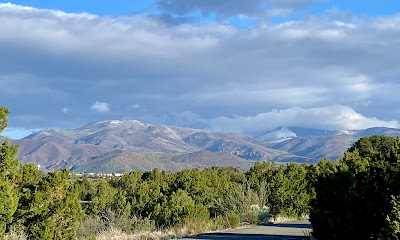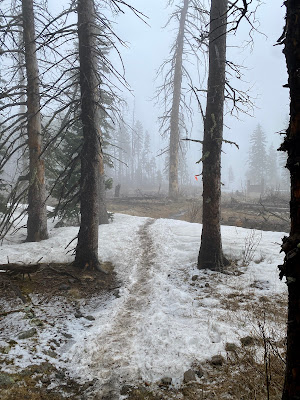Last weekend I ran the Jemez Mountain Trail 50K in Los Alamos, NM, where scenes from the movie Oppenheimer were filmed. Sadly, I have not seen the flick yet, but have read a lot about the Manhattan Project and am intrigued by physics and nuclear energy. I’m amazed by the fact that within 2-3 years scientists and others working in Los Alamos, were able to create and detonate “The Gadget”, “Little Boy” and “Fat Man”, the first three nuclear bombs. Although I’m no fan of nuclear weapons, war or other human atrocities, I find the ingenuity, determination and spirit of the men and women who worked on this project to be very inspiring.
The National Park Service recently established the Manhattan Project National Historical Park.
Established in 2015, the Manhattan Project National Historical Park preserves and interprets the nationally significant historic sites, stories, and legacies associated with the top-secret race to develop atomic weapons during World War II. —USNPS
Many of the sites in the park aren’t open to the public yet, but I believe there are guided tours for some of them.
The real gem of this area though, and reason it was chosen, is the surrounding mountains, canyons and mesas of this remote area of northern New Mexico. The abundant scenery and peace and quiet in the Santa Fe National Forest creates a serene atmosphere, perfect for hiking and running.
 |
| Jemez Mountains as seen from town |
This was my 10th time running this race with an equal amount of varied experiences to include altitude sickness, weather related adventures and much pain and suffering resulting in five 50 mile finishes, three 50K finishes and a couple DNFs. Ten years ago when I was here, a freak snow storm closed the course midway through the race. Some runners were caught off guard, especially near the 10,400’ summit, leading to hypothermia so race officials are very strict about requiring runners to carry mandatory rain gear, hat and gloves. The Jemez mountains are remote and threatening weather can pop up at any time of the year.
Read my post: Running Adventure Gone Wrong
 |
| Text alert system |
 |
| Valle Caldera, alluvial fans and Los Alamos |
Running into Pipeline aid station:
The mounds of snow and muddy spots were slippery and difficult to negotiate without sliding partway back down the slope. My lungs were working overtime in the thin air and my heart was pounding quickly. I took my time, not focusing on anything except each foot moving higher up the mountain. I reached a dirt road and followed the flagging right for a short distance and then turned left continuing up another steep and treacherous trail. Finally I made it to the top and walked for a while to let my heart and lungs recover from the taxing effort. In all, it took me one full hour to cover one mile from the ski lodge to the Pajarito Summit at 10,400’! There wasn’t much of a view, but the sun was trying its best to filter through the fog. The snow covered trail weaved through tall ponderosa pines, then over tufts of tall grass protruding through large rocks.
 |
| Pajarito summit |
 |
50K Course Flyover: |
It was a long trek down, but I made it to the Camp May Rd aid station at around mile 21.5 to fill up my water bottles. As soon as I left, I heard loud cracks of thunder overhead; large drops of rain began to fall and the temperature dropped quickly. Nothing to do, but keep running, so I pulled on my hood. Soon I came to one of my least favorites parts of this course. Just before entering Los Alamos National Lab land (NO PHOTOGRAPHY!), there is a short but very steep slippery sandstone descent. I usually pull out my poles for this section, but was feeling too lazy. Instead, I opted to butt scooting down parts of this treacherous trail.
 |
| Yep! |
I ran a narrow deep path full of water and ice which soaked my shoes. I crossed another road and ran under power lines while flashes of lightning were quickly followed by thunderous booms. I ran down an eroded hill, that was more like a muddy stream, anticipating the moment when the power lines might come crashing down on top of me. I was not in a good place, but just kept running.
Pretty soon I reached another dreaded cliff-like descent to the city ice rink where the next aid station was located. Narrow steep switchbacks are risky enough, but now they were covered in an inch or more of ice. If you slip off the trail here, you’re going down in a very bad way. I approached cautiously letting another runner go in front of me. I thought to myself, let him test out the waters first; see if he goes ass-over-teakettle! He seemed to have made it OK and he didn’t have poles but nevertheless, I took my sweet time going down.
I made it to the Ice Rink aid (mi 25) where some volunteers were sheltering in the back of a box trailer. I tried to pull one of my collapsible water bottles out of my vest pocket, but my fingers were numb and practically useless. A kind volunteer offered to grab it for me and filled it up so I could be on my way. I thought about dropping out of the race at this point, but realized that I would have to stand around in cold wet clothes waiting for a ride, which is a recipe for hypothermia.
 |
| I took these in town the day after. |
Anyway, with no time to lose, I took off and reached a hail covered highway that passes through a narrow canyon. An SUV drove past creating deep ruts in the slush. I plodded through to the other side and climbed a series of switchbacks leading up another steep cliff-like face. Surprisingly, the trail wasn’t too slippery because the ice was very wet and slushy, but the steepness took it out of me. I was really ready for this race to be over, but I still had another seven miles to cover.
The rain and hail stopped, but I became chilled whenever the sky darkened and the wind picked up. I had a dry expedition weight thermal shirt in my pack just in case, but I didn’t want to stop to put it on. I figured as long as I kept running, the effort would keep me warm enough. The route was hard to follow now, because it traverses snow covered slabs of rock; I mostly followed runners’ footprints while watching for course markings. Several times my foot sunk down into ankle deep puddles re-soaking my socks and shoes. It didn’t matter at this point, I was drenched to the bone.
My progress was slow, but I eventually made to the last aid station that looked like a tornado had struck. The shelters were blown down and a volunteer was on the phone tracking the location of runners who may have dropped out of the race. He asked if I was going to continue on and I said, “yes, all I want to do now is blast home!” He filled up my water bottles and sent me on my way. The last four miles weren't too bad; there was quite a bit of downhill and flats to run, but the mud and slush made the footing dicey in spots. I was really beat after a rough day in the mountains and longed for a hot shower and dry clothes.
 |
| Mitchell Aid before and after (photo: JMTR) |
 |
| Race text alert system |
 |
| Jemez finishers' award |
“What an adventure, but amazing support from kind people, volunteers, friends in the wilderness medicine community and complete strangers, who opened their homes to a dozen shivering runners.” —Adam Delu
Read more here: Runner Describes How Severe Weather Affected 2024 Jemez Mountain Trail Run Events Saturday
 |
| Indian paintbrush |
See you on the trail.









